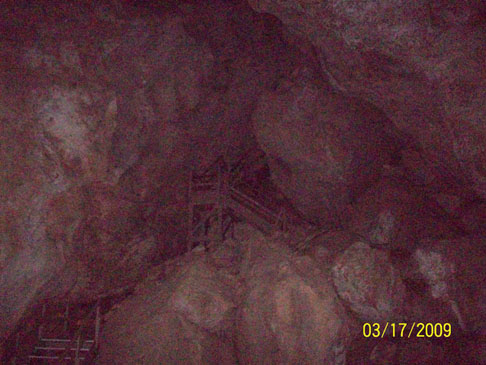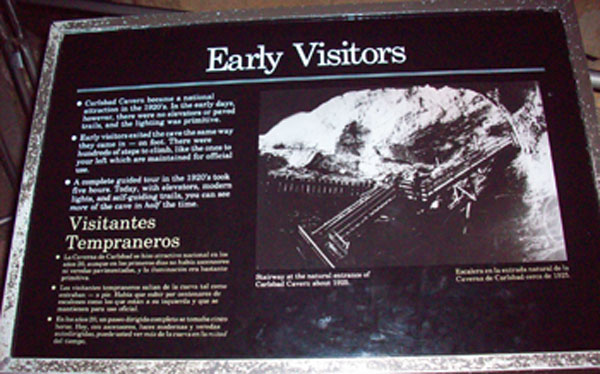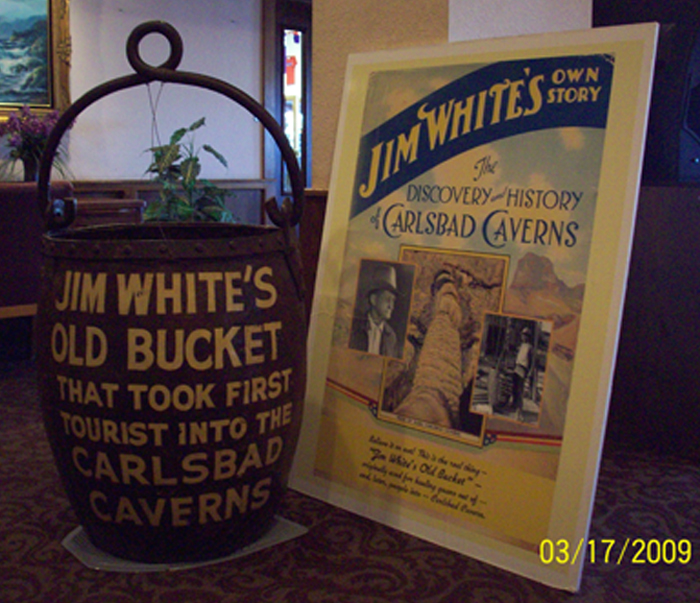 |
 |
"Why--in the name of all that is sky-blue and grass-green do all these
cavers go into caves when the world has a wealth of beauty and adventure
in the sunshiny outdoors? ... Cavers crawl into the Earth's bowels
because they were born with the curiosity of a 'coon, eternally poking
and prying and exploring from cradle to grave" (Pittman 1999). Such
curiosity drove Jim White, a 16-year-old Texas cowhand to first brave
the bowels of Carlsbad Caverns via a jury-rigged ladder somewhere in the
late 1890's.  It would take ten years before he could convince anyone
other than another young Mexican hand to accompany him down into the
frightening bat-filled entrance pit. His stories of huge rooms full of
stone icicles were scoffed at, but a small crew of townspeople were
willing to brave the descent just far enough to begin mining bat guano
to be sold as fertilizer. Occasionally, a miner would accompany Jim a
little further down one of his hand-made trails with a kerosene lantern,
but still their descriptions were regarded as tall tales. Finally,
perhaps twenty years after Jim's first foray, two visitors to town asked
to see Jim's cave. "Even then, they were not local people. They were
young adventurers making a cross-country trip by car, which was a real
feat at that time. By chance, they stopped at Carlsbad and heard of the
cave. Furthermore, they were able to persuade a local commercial
photographer to accompany them" (Halliday 1959, 131). Those photos by
Ray V. Davis confirmed the validity of Jim's tales and visitors began
requesting tours, initially carried out by lowering tourists down a
180-foot shaft in the oversized guano bucket.
It would take ten years before he could convince anyone
other than another young Mexican hand to accompany him down into the
frightening bat-filled entrance pit. His stories of huge rooms full of
stone icicles were scoffed at, but a small crew of townspeople were
willing to brave the descent just far enough to begin mining bat guano
to be sold as fertilizer. Occasionally, a miner would accompany Jim a
little further down one of his hand-made trails with a kerosene lantern,
but still their descriptions were regarded as tall tales. Finally,
perhaps twenty years after Jim's first foray, two visitors to town asked
to see Jim's cave. "Even then, they were not local people. They were
young adventurers making a cross-country trip by car, which was a real
feat at that time. By chance, they stopped at Carlsbad and heard of the
cave. Furthermore, they were able to persuade a local commercial
photographer to accompany them" (Halliday 1959, 131). Those photos by
Ray V. Davis confirmed the validity of Jim's tales and visitors began
requesting tours, initially carried out by lowering tourists down a
180-foot shaft in the oversized guano bucket.
These original tourists were likely motivated by the same curiosity and
healthy sense of adventure that inspired Jim White. As Pittman
explains, "caves are often thought of as dark, dirty, uninviting holes
in the ground posing unknown dangers, the risk of getting lost, and a
good chance of injury or death for those who explore them. Yet that
unknown also exerts a strong pull on human curiosity-- the quality that
moves people to explore the mysteries of the world about them" (1998).
 Early visitors risked life and limb for the chance to encounter the
hidden landscapes below. In discussing authenticity in tourism, McLeod
cites Wang's 1999 argument that "tourism activities that involve a close
association with the countryside ... are therefore popular because they
allow individuals to test themselves and rediscover their essential
selves" (Mcleod, 188). Tourists tested their mettle in a spectacular
underground realm. In Orion Knox's view, "Caving is the only activity
in which the average person can hope to go places and see things no one
ever has seen before" (Pittman 1999). Within a few short years, reports
of these visits accompanied by more authenticating photographs led to
exploration by scientific parties, mapping further development of trails
and the establishment of the caverns as a National Monument.
Early visitors risked life and limb for the chance to encounter the
hidden landscapes below. In discussing authenticity in tourism, McLeod
cites Wang's 1999 argument that "tourism activities that involve a close
association with the countryside ... are therefore popular because they
allow individuals to test themselves and rediscover their essential
selves" (Mcleod, 188). Tourists tested their mettle in a spectacular
underground realm. In Orion Knox's view, "Caving is the only activity
in which the average person can hope to go places and see things no one
ever has seen before" (Pittman 1999). Within a few short years, reports
of these visits accompanied by more authenticating photographs led to
exploration by scientific parties, mapping further development of trails
and the establishment of the caverns as a National Monument.
Over time, the guano bucket disappeared, to be replaced by a wooden staircase allowing visitors access to the depths of the cavern. The staircase itself remains in the cave for visitors to view along with a display panel describing it. This inaccessible, decrepit staircase joins the current visitor to those earlier explorers, making them participants in establishing the cave's value and providing the awe of discovery vicariously. The exhibit serves to "deploy a rhetoric of realism" (Rose 2007, 186) sufficient to connect current & historical participants while more subtly reinforcing the notion that such momentous performances of value are meant to be photographed, a central theme in the cavern experience.
 | The guano bucket too, has developed its own autobiography. It appears in numerous photographs accompnaying the stories of Jim White and Carlsbad Cavern's original discovery. Heavily woven into the discursive of explorers discovering new frontiers, the bucket itself has become a matter of speculation and (re)presentation in touristic form. One motel in run-down White City makes a less realistic claim than the stairs-- by claiming to possess Jim White's original bucket. However, lacking the institutional presence of the cave site, th motel has no historical or scientific discourses through which to validate their claim, so the average tourist views the bucket with suspicion. |
Unlike the original explorers and early tourists, today's tours are designed to ensure the safety of the visitor as modern show caves are "equipped with lights and graded with trails that allow ordinary folks to explore their interiors" (Pittman 1999), but the participatory themes of touring still draw on the same subjectivites--perhaps in the post-modern tourist more than ever. "An exaggerated wide-open space seduces the viewer because it "taps into and re-imagines the pre-existing mythologies of neocolonial desires of discovery and exploration of vast empty land, which is no longer possible" (Thurlow & Gendelman 2007, 17). The discovery explorer subjectivity motivated by the cave wants to commune with history, relive the moment of discovery, and test their own mettle through negotiated resistance.
[ Back ] | [ Continue Tour ] |